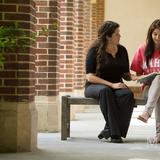- For over a century, Memorial Hospital School of Nursing at Albany Memorial Hospital and Samaritan Hospital School of Nursing have provided students with specialized knowledge, practical skills and caring values, preparing them for fulfilling and rewarding careers in nursing.
School Highlights
Samaritan Hospital School of Nursing serves 160 students (11% of students are full-time).
The college's student-teacher ratio of 10:1 is lower than the state community college average of 13:1.
Minority enrollment is 55% of the student body (majority Black), which is less than the state average of 62%.
Quick Facts (2025-26)
- Enrollment: 160 students
- In-state tuition: $11,211
- Out-state tuition: $11,211
- Acceptance Rate: 75%
- Student-teacher ratio: 10:1
- Minority enrollment: 55%
- Source: Integrated Postsecondary Education Data System (IPEDS)
School Overview
The teacher population of 16 teachers has stayed relatively flat over five years.
Samaritan Hospital School of Nursing
(NY) Community College Avg.
Carnegie Classification
Special Focus Two-Year: Health Professions
Baccalaureate/Associate's Colleges: Mixed Baccalaureate/Associate's
Institution Level
Less than 2 yrs
At least 2 but less than 4 years
Institution Control
Public
Private not-for-profit
Total Faculty
16 staff
159 staff
Student Body
The student population of Samaritan Hospital School of Nursing has grown by 17% over five years.
The student-teacher ratio of 10:1 has stayed the same over five years.
The Samaritan Hospital School of Nursing diversity score of 0.69 is less than the state average of 0.76. The school's diversity has grown by 119% over five years.
Total Enrollment
160 students
1,129 students
Student-Teacher Ratio
10:1
13:1
# Full-Time Students
17 students
528 students
# Part-Time Students
143 students
601 students
# Enrollment Undergraduate
160 students
357 students
# Full-Time Undergraduate Students
17 students
519 students
# Full-Time Graduate Students
n/a
44 students
# Part-Time Undergraduate Students
n/a
850 students
# Part-Time Graduate Students
n/a
41 students
Total Dormitory Capacity
n/a
382 students
% American Indian/Alaskan
1%
n/a
% Asian
4%
8%
% Hispanic
4%
23%
% Black
11%
18%
% White
45%
38%
% Hawaiian
30%
2%
% Two or more races
1%
3%
% Non Resident races
n/a
3%
% Unknown races
3%
5%
Diversity Score
0.69
0.76
College Completion Rate (Students who graduate in less than 4 years)
33%
33%
College Completion Rate (Students who graduate in 4 years or more than 4 years)
n/a
40%
Average Graduate Earnings (10 Years)
$48,200
$35,200
Tuition and Acceptance Rate
The public in-state tuition of $11,211 is more than the state average of $5,902. The in-state tuition has declined by 21% over four years.
The public out-state tuition of $11,211 is more than the state average of $10,404. The out-state tuition has declined by 21% over four years.
In-State Tuition Fees
$11,211
$5,902
Out-State Tuition Fees
$11,211
$10,404
Tuition Notes
$450 per credit
% Students Receiving Some Financial Aid
50%
88%
Median Debt for Graduates
$15,250
$13,841
Median Debt for Dropouts
$4,750
$5,500
Acceptance Rate
75%
74%
SAT Reading
n/a
475
SAT Math
n/a
505
SAT Writing
n/a
485
ACT Composite
n/a
20
ACT English
n/a
18
ACT Math
n/a
20
Source: 2024 (or latest year available) Integrated Postsecondary Education Data System (IPEDS)
School Notes
- Because Memorial School of Nursing and Samaritan Hospital School of Nursing are sister schools, classes may be shared and held on either campus. Both schools have classroom and clinical laboratory facilities where students attend nursing theory classes, then practice and enhance their skills. We also have a relationship with Hudson Valley Community College where students complete curricular requirements in the sciences and humanities. Since our schools are affiliated with Northeast Health, the region's most comprehensive network of healthcare and community services, students can participate in clinical and observational experiences in a variety of care settings, including hospitals, nursing homes, physician offices and daycare centers. Samaritan Hospital School of Nursing also offers a Licensed Practical Nurse Certificate (LPN) program. Practical nurses are important members of the healthcare team and can be found anywhere healthcare is delivered � in hospitals, nursing homes and other exciting settings. Our Registered Nurse (RN) program will educate and prepare students to become skilled and competent professional nurses. Graduates earn a two-year associate's in science degree and are eligible to apply for the National Council Licensure Exam required for licensure as a RN. In addition, graduates of the RN program can pursue a BSN degree at Russell Sage College, SUNY College of Technology at Utica/Rome, SUNY at New Paltz, Pace University, Lienhard School of Nursing, and SUNY at Plattsburgh with junior status in accordance with the individual college's admission standards and curriculum guidelines. Our dynamic faculty come from diverse backgrounds with extensive professional experience � providing you with the very best in classroom instruction and clinical skill-building. Faculty members believe that nursing is a blend of both scientific knowledge and the art of caring and promote a holistic approach to patient care. And, our low student/teacher ratio allows for more personalized attention.
Frequently Asked Questions
How much does Samaritan Hospital School of Nursing cost?
Samaritan Hospital School of Nursing's tuition is approximately $11,211 for In-State students and $11,211 for Out-State students.
What is the acceptance rate of Samaritan Hospital School of Nursing?
The acceptance rate of Samaritan Hospital School of Nursing is 75%, which is higher than the state average of 74%.
Recent Articles

The Rise of Technical and Vocational Training in 2025
Explore the 2025 surge in technical and vocational training—enrollment, policy, costs, and why this path is gaining ground for students and parents.

Stackable Credentials: How Community Colleges Advance Careers
Discover how community colleges use stackable credentials to build career pathways, boost earnings, and enable lifelong learning in 2025.

High-Paying Jobs You Can Get with a Community College Degree
Discover top high-paying careers you can launch in 2025 with a community college (associate) degree and high-growth credentials in tech, healthcare and trades.











